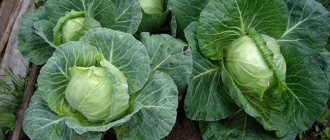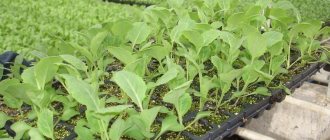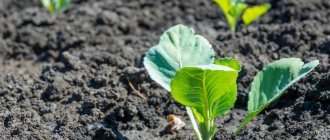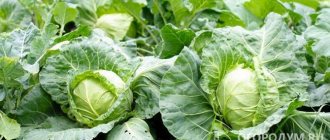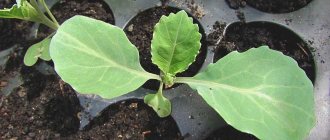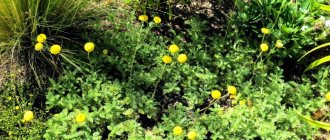Author: Elena N. https://floristics.info/ru/index.php?option=com_contact&view=contact&id=19 Category: Garden plants Published: December 23, 2015Last edits: January 06, 2021
- When to plant
- Growing conditions
- White cabbage
Cabbage (lat. Brassica) is a genus of plants in the Brassica (Cruciferous) family, which includes such well-known cultivated plants as cabbage, turnips, radishes, turnips, rutabaga and mustard. About 50 species of the genus are known, distributed in Central Europe, the Mediterranean, East and Central Asia. Only species exported from Europe grow in America. Cabbage was grown for food by the ancient Egyptians, Greeks and Romans; it began to feed humanity 4,000 years ago. Cabbage was brought to our territory from Western Europe by merchants during the heyday of Kievan Rus - in the 13th century, and by the 18th century it had already become so firmly established in Russian life that a tradition was formed after the Orthodox holiday. Exaltation, which is celebrated on September 27, collectively prepared cabbage for the winter - it was chopped and salted, and at the same time, for two weeks, cheerful folk games were held, which were called kasputniki. In the 19th century, the prominent Russian vegetable grower Rytov was able to name 22 varieties of cabbage.
Planting and caring for cabbage
- Planting: seedlings of early varieties are sown from the beginning of March until the third ten days of the month, mid-season varieties - during the month from March 25, late varieties - from the beginning of April until the third ten days of the month. Transplanting seedlings into open ground - after 45-50 days.
- Lighting: bright sun from morning to evening.
- Soil: for early combs – loamy and sandy, for mid-season and late combs – loam and clay. Hydrogen index 6.0-7.0 pH.
- Predecessors: It is not advisable to grow after cruciferous crops.
- Watering: after planting in the ground, the seedlings are watered every evening for a week. Subsequently, watering is carried out in the evening or in cloudy weather once every 5-7 days, and in hot weather and drought - every 2-3 days.
- Hilling up: three weeks after planting, then another 10 days.
- Mulching: a layer of peat mulch up to 5 cm thick is recommended.
- Feeding: three feedings with complete mineral fertilizer during the seedling period, then with ammonium nitrate when the leaves begin to grow, the last one - at the moment when the leaves begin to curl into a head of cabbage.
- Reproduction: seedlings from seeds.
- Pests: aphids, caterpillars, slugs and snails, cruciferous bugs and flea beetles, cabbage leaf beetles and secretive proboscis.
- Diseases: clubroot, black leg, downy mildew, fusarium, rhizoctonia, white and gray rot.
Read more about growing cabbage below.
Features of cultivation in the regions
The climatic conditions of different regions determine some of the characteristics of cultivation and care.
In Ukraine
The climate of Ukraine is moderate continental with a gradual increase in continentality from west to east. With the exception of the western mountainous regions, the territory is steppe and forest-steppe. Hot, dry winds often blow. Periods without precipitation sometimes reach 2-3 months, but it sometimes happens that it rains continuously for a month. The cold comes quite late; sometimes in November the temperature does not drop below 10°C.
Botanical description
The agricultural crop cabbage (lat. Brassica oleracea) is a biennial plant with a tall leafy stem, bare gray or bluish-green leaves. The lower fleshy, large, petiolate, lyre-pinnately dissected leaves, adjacent to each other, form a rosette - a head of cabbage around the stem, the upper leaves are oblong, sessile. Large flowers form a multi-flowered raceme. Cabbage seeds are also large, dark brown, spherical, about 2 mm long.
Cabbage contains mineral salts of calcium, potassium, sulfur and phosphorus, fiber, enzymes, phytoncides, fats, vitamins A, B1, B6, K, C, P, U and others. According to some scientists, cabbage comes from the Colchis lowland, where similar plants, called “kezhera” by local residents, still grow in variety. The cabbage species includes such well-known varieties as white and red cabbage, as well as cauliflower, savoy, Brussels sprouts, Portuguese, kohlrabi, broccoli, Chinese, Chinese and kale cabbage.
Hilling
To stimulate the formation of lateral roots in cabbage, it must be hilled at least twice a season. During the hilling process, a small tubercle is formed around the plant. This allows you to reduce the number of weeds, stimulate the formation of adventitious roots, and saturate the soil with oxygen. It is recommended to start hilling when real leaves appear on the cabbage. The procedure can be repeated after 2 weeks. The cabbage is hilled a third time when a head of cabbage begins to form.
Growing cabbage from seeds
How to sow seeds
The quality of cabbage primarily depends on the seed, so be responsible when purchasing seeds and before growing cabbage seedlings, think about why and when you want to get it - do you need an early vegetable with delicate leaves for salads or strong, dense heads of cabbage? for winter storage and salting. The choice of variety and sowing time will depend on the intended purpose of the cabbage you grow.
- Optimal timing for planting cucumber seedlings
Widely cultivated by amateur gardeners, white cabbage, without which no borscht is complete, comes in early varieties that are suitable only for eating in the summer, mid-season varieties that can be eaten fresh in the summer or can be salted for the winter, and late varieties that More than any other, they are suitable for long-term storage.
Sowing of early varieties of cabbage for seedlings is carried out from the first days of March to the twentieth of the month, seeds of mid-season varieties are sown from March 25 to April 25, and late cabbage is sown from the beginning of April to the third decade of the month. From the moment of sowing until the seedlings are planted in open ground, it usually takes 45-50 days.
If you have decided on your desires and purchased the seeds of the desired varieties, it’s time to think about making soil for seedlings. Professionals recommend preparing the soil mixture in the fall so that you don’t have to extract the ingredients from under the snow in winter. Mix one part each of humus and turf soil, add ash at the rate of 1 tablespoon per kilogram of soil and mix the composition well. The ash will act as an antiseptic and a source of macro- and microelements, preventing the appearance of black leg on cabbage seedlings.
You can prepare a mixture of a different composition, based on peat, for example - the main thing is that it is fertile and breathable. Never use garden soil from a plot where cruciferous crops were grown to grow seedlings, as it is likely that it contains pathogens that can affect the seedlings.
Growing cabbage begins with heating the seeds for 20 minutes in water at a temperature of about 50 ºC, after which they are immersed in cold water for 5 minutes to increase the immunity of the seed to fungal diseases. Then the seeds are immersed for several hours in a solution of a growth stimulant - Humate, Epin, Silk, etc. However, there are varieties whose seeds cannot be wetted - carefully read the instructions attached to the bag of seeds.
Water the soil generously before sowing and do not moisten it further until germination. The seeds are sown to a depth of 1 cm, then the container is covered with film or paper on top so that moisture from the top layer of soil does not evaporate, and the crops are kept at a temperature of 20 ºC.
Growing seedlings
Shoots appear already on the 4-5th day, after which the film or paper is removed, the temperature is lowered to 6-10 ºC and the seedlings are kept in these conditions until their first true leaf appears. To do this, it is best to place the container with seedlings on a glassed-in loggia, and usually a week is enough to achieve the expected result. After the leaf appears, the temperature on sunny days is increased to 14-18 ºC, on cloudy days it should be within 14-16 ºC, and at night – 6-10 ºC.
Caring for cabbage seedlings at this stage provides the plants with access to fresh air, but the seedlings must be protected from drafts. In addition, seedlings need additional illumination with a fluorescent or phytolamp: their daylight hours should be at least 12-15 hours a day.
Do not allow the soil to dry out or become waterlogged - this can be avoided by regularly loosening the soil after watering. A week after the emergence of seedlings, the soil is watered with a weak solution of potassium permanganate at the rate of 3 g of potassium permanganate per 10 liters of water, or a weak solution of copper sulfate.
Cabbage pick
One and a half to two weeks after the emergence of seedlings and the formation of the first true leaf, the plants dive, providing the seedlings with a large feeding area. An hour before planting the cabbage, the soil with the seedlings is watered abundantly, then each seedling is removed along with a lump of earth and, having shortened its root by a third of its length, it is planted in an individual cup (preferably peat-humus), buried down to the cotyledon leaves.
Picking can be avoided if the initial sowing of cabbage seeds is carried out in individual containers - when transplanting seedlings into open ground from personal pots, the root system of the seedlings is not so damaged, and by the time the seedlings are planted in the garden bed, it will have already developed to a decent size. If you grow seedlings in peat-humus pots, then you can plant the seedlings in the ground directly in them.
Planting cabbage in the ground is preceded by two weeks of hardening, the purpose of which is to prepare the seedlings for development in new conditions. The first two days in a room with seedlings, open the window for 3-4 hours, providing protection for the seedlings from drafts. Then, over the course of several days, the seedlings are taken out for an hour or two on a balcony or loggia under the sun’s rays, from direct exposure of which the seedlings must first be covered with gauze.
After a week, reduce watering, take the seedlings to the balcony and keep them there until planting in the ground.
- Rutabaga: growing from seeds in the garden, varieties
Preparing the bed for growing
Before planting seedlings in open ground, beds are prepared for them. Choose a place for cabbage that is open, sunny, ventilated, but without drafts or strong winds blowing through it. The soil should be soft, loose, moist, but not wet, because cabbage loves moisture, but does not tolerate “swamp”. It is desirable that such a site should previously have grown crops belonging to the legume, nightshade and pumpkin families, as well as root vegetables, but not cabbage itself.
The beds for cabbage have been prepared since the fall:
- The remnants of the previously growing crop and weeds are removed from the ground.
- Then they dig it up to a depth of no less than 30 cm.
- At the same time, organic matter is added to each m2 of land - 5 kg of well-rotted humus or compost.
- If the soil is acidic, it is neutralized with chalk or lime.
In the spring, the beds are dug up again and minerals are added to the soil - 1 tbsp. l. saltpeter and superphosphate, with the addition of 1 cup of ash per 1 m2. To save fertilizer, you can put it in the hole when planting cabbage. In this case, pour 1 tablespoon of ash and two handfuls of rotted compost, as well as 1 tsp. into each planting hole. nitroammofoski. Mix everything thoroughly with the soil.
Planting cabbage in open ground
When to plant
Planting early cabbage seedlings in open ground is carried out when the seedlings develop 5-7 leaves, and the seedlings reach a height of 12-20 cm. The parameters for planting mid-season and late cabbage seedlings in open ground are as follows: the presence of 4-6 leaves at the height of the seedlings is 15-20 cm. Typically, seedlings of early varieties achieve such results by the beginning of May, late varieties - from mid to late May, and mid-season varieties - from late May to mid-June.
Soil for cabbage
Before planting cabbage, you need to prepare a plot for it. It should be illuminated by the sun from morning to evening. As for the soil, loam and sandy soil are most suitable for early varieties of cabbage, while loam or clay soil is optimal for middle and late varieties. The hydrogen index on sandy soils should be ± 6.0, and on clay-sandy or clayey soils - ± 7.0. Acidic soils are unsuitable for cultivating cabbage.
This crop cannot be grown in areas infected with bacteriosis for eight years. It is also undesirable to plant cabbage where other cabbage crops were recently grown - turnips, radishes, radishes, turnips, mustard, rutabaga or cabbage. Before the area where these crops grew can be used for cabbage, at least three years must pass.
The soil in the area for cabbage should be prepared in advance, from the first days of autumn preceding planting: in dry weather, carefully dig the area to the depth of a spade bayonet, but do not try to level the surface, because the steeper the unevenness, the more moisture it can absorb over the winter and spring. Earth.
After the snow melts, the so-called “moisture sealing” is carried out - the soil surface is leveled with a rake to prevent water from evaporating too quickly from the soil. Very soon weeds will creep out of the ground and must be removed immediately.
How to plant in open ground
The scheme for planting seedlings in open ground is approximately as follows:
- 30x40 for hybrid and early varieties, 50x60 for mid-season and 60x70 for late varieties of white and red cabbage;
- 30x40 for kohlrabi;
- 25x50 for cauliflower;
- 60-70 for Brussels sprouts;
- 40x60 for Savoy;
- 30x50 for broccoli.
Try not to overcrowd the beds, as cabbage needs a lot of light and space.
Make holes in the soil slightly larger than the root system of seedlings with an earthen ball or peat-humus pot. Place a handful of sand and peat, two handfuls of humus and 50 g of wood ash in each hole, add half a teaspoon of nitrophoska, mix the additives thoroughly and water generously. An earthen ball with the root system of the seedling is dipped directly into this slurry, sprinkled with damp soil, pressed lightly and dry soil is added on top. Seedlings that are too elongated are planted so that the first pair of leaves is level with the surface of the site.
Direct sowing of seeds in the ground under plastic bottles
This is an alternative method of growing cabbage that can be used by gardeners in the southern regions of the Russian Federation. In this case, plastic bottles will play the role of mini-greenhouses for each individual plant. 1.5-2 liter transparent bottles are suitable, the bottom of which is cut off, but the lids are left on.
Before sowing, seeds are soaked for 30 minutes in a solution of potassium permanganate to disinfect them, and then washed in clean running water. Afterwards, they are left in a wet cloth for germination for 1 day.
The beds are prepared for seeds in the fall and spring in the same way as for seedlings, but in this case they are made narrow and tall. Holes for cabbage are made using a glass bottle of suitable size. Use it to press even round holes, pour 2 tbsp into them. l. ash, water it, and then sow seeds there. When planting cabbage, place 3-4 of them in each hole, because not all seeds germinate equally well. They are carefully sprinkled on top with a thin layer of dry earth or humus, and then a bottle with a screwed cap is placed in each hole. In the intervals between the plants, fast-growing greens are sown - dill or lettuce, which can be cut before the plants under the bottles grow up.
When sowing cabbage in open ground, water the seeds through the neck of the bottle, opening the lids for a while. After some time, check how the seeds have sprouted. If it turns out that several have sprouted in a single hole, then 1 plant, the strongest one, is left in it, and the rest are removed or, if possible, planted in other beds. Watering and fertilizing are carried out in exactly the same way as in the case of seedlings. When the plants under the bottles have grown and become strong enough, the greenhouses are removed.
Cabbage care
Growing conditions
At first, carefully monitor the planted seedlings in order to put the fallen seedlings back in place in time. If weather forecasters predict sunny days, shade the seedlings from the sun for a while with newspapers or non-woven material. For a week, water the seedlings every evening from a watering can with a divider; after this period, if night frosts are not expected, the cover can be removed. Further care of seedlings in open ground consists of watering, loosening the soil, weeding the area, regular feeding and treating cabbage from pests and diseases. Three weeks after planting, the cabbage is earthed up, and after another 10 days the earthing procedure is repeated.
Watering
Growing cabbage in open ground will require you to strictly adhere to the watering regime, since the plant needs a lot of moisture. How to water cabbage already planted in open ground? Watering is carried out in the evening; on cloudy days, a gap of 5-6 days is sufficient between heavy waterings; in hot weather, watering will have to be done every 2-3 days. After watering, loosen the soil in the area while hilling up the cabbage. Professionals recommend using a 5 cm thick mulching layer of peat - it retains moisture in the soil longer and at the same time serves as food for developing plants.
Top dressing
7-9 days after picking the seedlings, it is necessary to apply the first fertilizing consisting of 2 g of potassium fertilizer, 4 g of superphosphate and 2 g of ammonium nitrate dissolved in 1 liter of water - this amount should be enough to fertilize 50-60 seedlings. To avoid burns, fertilize cabbage using pre-watered soil.
The second feeding is applied two weeks later and consists of double the amount of the same fertilizer dissolved in the same amount of water. If the seedlings are slightly yellowed, feed them with a liquid solution of fermented manure at a rate of 1:10.
The third, so-called hardening fertilizer is applied two days before planting seedlings in open ground, and it consists of 3 g of ammonium nitrate, 8 g of potassium fertilizer and 5 g of superphosphate, dissolved in a liter of water. A high concentration of potassium fertilizers promotes the survival of seedlings in open ground. If you do not have enough time to prepare a nutrient mixture, use ready-made liquid complex fertilizer Kemira Lux.
If you fed cabbage in the seedling stage, its development promises to be fast and intense, but after planting in open ground, feeding the cabbage does not stop. How to fertilize cabbage when its leaves begin to grow? It is best to add a solution of 10 g of ammonium nitrate in 10 liters of water to the soil - this dose is calculated for 5-6 plants. When the leaves begin to form into a head of cabbage, apply a second feeding with a solution of 4 g of urea, 5 g of double superphosphate and 8 g of potassium sulfate per 10 liters of water at the same rate.
Treatment
The first time after planting in the ground, seedlings are dusted with ash with the addition of tobacco dust - this measure will protect young plants from slugs and fleas. Cabbage is a food product, so using pesticides to treat it against pests and diseases is extremely undesirable and unwise.
- Use of mustard against pests
How to process cabbage in order to destroy its enemies and at the same time not poison the product that we are going to eat? There are many ways to protect garden crops from such scourges as the invasion of aphids, caterpillars, pests of larvae and gastropods - snails and slugs.
Aphids and caterpillars can be destroyed by spraying with the following infusion: 2 kg of tomato tops are poured with 5 liters of water, left for 3-4 hours, then boiled for 3 hours, allowed to cool, filtered and diluted with water 1:2. To ensure that the infusion “sticks” to the leaves and does not flow onto the ground, add 20-30 g of grated tar soap to it. An infusion of onion peels can be used in the fight against aphids and caterpillars: pour a liter jar of onion peels with two liters of boiling water and leave for two days, then filter, add another 2 liters of water and a tablespoon of liquid soap or dishwashing detergent.
To combat the larvae of the May beetle, armyworm or cabbage fly, ants are attracted to the site by burying a jar of honey or jam diluted with water. Attracted by the sweet, black ants will also eat the larvae.
A preventive measure in the fight against harmful insects can be considered by placing marigolds, mint, sage, cilantro, basil, rosemary and other herbs in the area with cabbage and around it. The tart aroma will repel aphids, butterflies, slugs, fleas and attract their eternal enemies to fight them - ladybugs, lacewings, beetles and others.
Timely watering
A very important condition for successfully growing cabbage is watering it. Ideally, soil moisture should be constantly at 85%. You can’t water cabbage in hot weather. Watering should be done in the evening or morning. In the first half of summer, it is necessary to moisten the soil every 3 days, pouring half a bucket of water under 1 plant. Starting in mid-July, watering should be done once a week, increasing the water consumption rate to 1 bucket. It is recommended to alternate regular watering with additional chewing, during which the stream of water should be directed directly over the foliage. All water procedures must be completed 20 days before harvesting. If it is not possible to frequently water the cabbage in the traditional way, you can use drip irrigation. With this method, the soil will be constantly moistened and the cabbage will develop well.
At remote dachas, you can dig plastic bottles into the soil, make holes in them and fill them with water. This will ensure continuous soil moisture.
Cabbage diseases
Some cabbage diseases can spread so quickly that a slight delay on your part can result in the loss of the entire crop. We will tell you why cabbage is sick, as well as how to treat cabbage to save it from death. One of the most dangerous diseases of the plant is clubroot, a common fungal disease that affects early varieties of white cabbage and cauliflower even at the seedling stage: growths form on the roots of the seedlings, disrupting the nutrition of young plants, causing the seedlings to lag behind in development - they do not even form an ovary. Remove diseased plants from the area along with a lump of earth, and sprinkle the place where they grew with lime.
It is not yet possible to grow cabbage in this place, but other plants can grow without any risk, since clubroot only affects cruciferous plants.
A common occurrence is cabbage being damaged at the seedling stage or already in the garden plot by blackleg, a fungal disease of the root collar at the base of the stem. These parts of the seedling turn black, become thinner, rot, the plant slows down and dies. Such seedlings are not planted in the ground - they will die in any case. The soil in the area with cabbage killed by blackleg needs to be replaced, because it is unsuitable for growing cabbage. To prevent the disease, seeds are treated with granosan before planting in accordance with the instructions; to treat 100 seeds, approximately 0.4 g of the drug is needed, and fifty percent Tiram (TMTD) is added to the soil at the rate of 50 g per m².
Sometimes cabbage suffers from downy mildew - downy mildew. Typically, pathogens are found in seeds, which is why pre-sowing treatment is so important. The disease appears in wet weather on the outer leaves of cabbage as faint red-yellow spots. As a result of the development of the disease, the leaves turn yellow and die. As a preventive measure, seed treatment with Tiram or Planriz is used before planting. Hydrothermal treatment also gives good results - soaking the seeds in hot water (about 50 ºC) for 20-25 minutes.
If preventive measures were not taken, or they did not help, you will have to resort to treating the cabbage with garlic infusion: add 75 g of finely chopped garlic to 10 liters of water, leave for 12 hours, then bring the infusion to a boil, let it cool and spray the plants. If this measure does not produce results, treat the cabbage with a two to three percent solution of Fitosporin-M. If necessary, treatment can be repeated after two to three weeks. But keep in mind that cabbage can be treated with a fungicide only before the head is set, otherwise there is a danger of toxic chemicals accumulating in the leaves.
White and gray rot also cause gardeners a lot of trouble. White rot develops under conditions of a combination of low temperature and high air humidity and is manifested by mucus on the outer leaves of cabbage, between which a cotton-like white mycelium with black sclerotia ranging in size from one millimeter to three centimeters is formed. A head of cabbage affected by white rot rots in storage, infecting neighboring forks.
Gray rot also appears during storage: the petioles of the lower leaves become covered with fluffy mold with black beaded dots. Pre-sowing seed disinfection, advanced agricultural technology, preventive cleaning and disinfection of storage facilities before planting cabbage, compliance with storage conditions, timely detection of the disease and cleaning of affected areas will help protect the cabbage harvest from these diseases.
A dangerous disease is fusarium wilt, or yellowing of cabbage, which is caused by the Fusarium fungus. Cabbage is affected by the disease even in the seedling period, and the death of young plants from this scourge sometimes amounts to 20-25%. Symptoms of the disease are loss of turgor in the leaves and the appearance of yellow spots on them. The development of leaves in areas of yellowing slows down, diseased leaves fall off. To prevent the disease from spreading, the affected plants are dug up along with the roots and burned, the soil is steamed or changed. Autumn and spring preventive treatment of the area with a solution of copper sulfate (5 g of the drug is dissolved in 10 liters of water) helps to destroy the fungus.
Rhizoctoniosis is another fungal disease of cabbage that develops with strong fluctuations in temperature (for example, from 3 ºC to 25 ºC), air humidity (from 40 to 100%), and soil acidity (hydrogen index from 4.5 to 8 units). The disease affects the root collar, causing it to turn yellow, dry out and die, the roots turn into sponges and the plant dies. Infection occurs already in open ground, the disease continues to develop even in storage. As a preventative measure, spray the soil before planting cabbage in the soil with copper oxychloride or preparations that contain it.
How to select and prepare white cabbage seeds?
The growing region plays a major role in the selection of seeds for sowing. The further north the site is located, the more early ripening varieties you need to choose. The description on the packaging contains the dates for sowing and estimated harvest of the crop.
But, as a rule, these data are indicated in case of strict adherence to agricultural technology of care and cultivation. Such violations, as well as failures in climatic conditions - drought, heavy and prolonged rains, prolonged frosts - negatively affect the agricultural technology of growing white cabbage.
The main task of preparing white cabbage seeds is to improve their germination and further healthy development of sprouts. To do this, a number of activities are carried out with seeds:
- Calibration;
- Hardening;
- Stratification - keeping wet seeds for a certain amount of time at low temperatures;
- Soaking in a disinfectant solution;
- Warming up;
- Treatment with microelements;
- Germination.
The process can be described as follows. After calibration, dry white cabbage seeds are placed in hot (about 45-50 C0) water for 15 minutes. Then immerse in cold liquid for a minute. Make a solution with microelements and put them in it for 12 hours. Afterwards they are washed with clean water and placed in the refrigerator for a day. All that remains is to dry the seeds and sow.
Cabbage pests
You learned how to destroy aphids, caterpillars, larvae and gastropods from the section on processing cabbage. But the plant has many enemies among insects, and in this section of the article we will talk about how you can get rid of other pests from the insect world. Serious enemies of cabbage are cruciferous bugs - colorful bugs up to a centimeter in size that overwinter in the soil. At the end of April they begin to feed on seedlings, at the beginning of summer the females lay eggs, after two weeks larvae emerge from them, and after a month adult bugs appear. These insects feed on cabbage juice by piercing its leaves. The puncture site becomes dead, and if there are many such areas, the leaves of the seedlings wither, dry out and die. Bugs cause the most severe damage to cabbage during drought.
As a preventive measure, it is necessary to remove from the site weeds from the Brassica family - rapeseed, silverweed, field grass, shepherd's purse, alyssum and fireweed. After harvesting cabbage, do not leave weeds on the site, collect them and burn them. Bedbugs can be destroyed by treating cabbage seedlings before the formation of heads of cabbage with Actellik or Fosbecid.
The cabbage leaf beetle, a small ovoid bug up to 5 mm long, damages plant leaves by eating holes in them or making indentations along the edges. Leaf beetles also overwinter in the soil, and in May their females lay eggs, from which larvae emerge after 10-12 days, feeding by scraping the skin from the leaves. As a preventive measure, it is necessary, as in the case of fighting bedbugs, to remove cruciferous weeds from the site. And you can scare away leaf beetles by daily morning spraying cabbage on dew with a mixture of tobacco dust with slaked lime or ash in a 1:1 ratio. Before the heads of cabbage begin to form, you can treat the cabbage with a two percent solution of Actellica or the less toxic biological preparation Bankol.
Another enemy of cruciferous plants is the secretive proboscis - a black bug up to 3 mm long. The larvae of the secretive proboscis are dangerous, gnawing passages in the petioles of leaves, penetrating the stem and descending through tunnels made in it into the root of the cabbage. In this case, the conducting system is damaged, the leaves turn yellow, the plants stop developing and die. In the fight against this pest, it is very important to remove plant debris from the site in the fall, and then dig up the soil. During the growing season, timely weeding and removal of plants affected by the pest from the site are important. Chemical agents that destroy the secretive proboscis are Actellik and Fosbecid, but treatment with insecticides is permissible only at the early stage of seedling development in open ground.
Don't forget to fight diseases and pests
Agricultural technology is agricultural technology, but if your cabbage is oppressed by diseases and pests, you will definitely not get a good harvest.
You will read in detail about the fight against all specific diseases and pests of cabbage in our thematic materials, but for now we will simply remind you of the list of products approved for use in private household plots, which would be nice to have on hand just in case.
To combat diseases and prevent their occurrence - Agat-25, Immunocytophyte, Sporobacterin, Fitosporin-M, BisolbiSan, Bordeaux mixture.
For the destruction of pests - Fitoverm, Biotlin, Antitlin, Aliot, Tabazol, Aktara, Bitoxibacillin, Lepidotsid, Iskra, Herold, Fufanon-Nova, Kinmiks, Karbotsin, Zemlin, Ferramol, Ulitsid, Bros, Groza-3, Slug-eater.
Do not forget also about effective sanitary and agrotechnical measures to prevent the occurrence of diseases and pests - maintaining crop rotation, weed control, thorough autumn digging of the soil, removing plant residues from the site, disinfecting garden tools, dusting plants with ash and tobacco dust.
- Photo identification of cabbage diseases and pests with descriptions and control measures
Want to quickly understand what's wrong with your cabbage and how to fix it? Especially for you, we have “squeezed out” the most important things.
- How to treat cabbage against pests
Cabbage is a common crop, but also very vulnerable to pests. How to protect it in the early stages of growth?
Cleaning and storage
Three weeks before harvesting, stop watering the cabbage - this measure stimulates the accumulation of fiber in the forks, which contributes to better storage of the cabbage. When the night temperature drops to -2 ºC, harvesting can begin. Do not delay harvesting, because at lower night temperatures the heads of cabbage freeze, which negatively affects their keeping quality. Dig up the cabbage along with the roots, sort it, putting aside small heads eaten by beetles or touched by rot - this cabbage cannot be stored, you will have to eat it or pickle it. Storable cabbage is placed under a canopy for a day so that it dries and slightly winds, then its stalks are cut off 2 cm below the head, leaving 3-4 covering green leaves on it. Now the cabbage can be placed in storage.
It is best to store vegetables in the cellar - there is usually high humidity and the temperature does not drop below zero. If the temperature in the cellar does not rise above 4-6 ºC in winter, then this is an almost ideal storage for cabbage, since the optimal conditions for storing cabbage heads are air temperature from -1 to +1 ºC, and humidity from 90 to 98%. But first you need to put the room in order: there should be no mold on the walls, despite the high humidity, and no debris on the earthen or cement floor. It is advisable to whitewash the walls with a solution of quicklime, after which the cellar is fumigated with sulfur. Make sure there is good ventilation as well. If there is no ventilation system, you will have to ventilate the cellar well at least once a month.
Cabbage is stored in a single layer on racks, as well as in a folded pyramid on wooden boards or hanging, wrapped in newspaper.
In order to keep cabbage fresh for as long as possible, gardeners resort to some tricks that we are ready to share with you:
- You can tie the heads of cabbage in pairs by the stalks and hang them from the ceiling on poles. In this position, there will be air access to the heads, they can be easily inspected for damage;
- store cabbage in lattice wooden boxes placed on stands or shelves - the main thing is that they do not stand on the floor;
- the heads of cabbage wrapped in paper are placed in a plastic bag without tying it and hung from the ceiling or placed on a shelf;
- The head of cabbage is placed in a ten-liter bucket of soil, then it is covered with earth on top and the bucket is placed in the cellar. Sand can be used instead of soil.
There are a couple more storage methods, but for them the root of the cabbage is not cut off, and the covering leaves, on the contrary, are removed. After this, the heads of cabbage are hung by the roots in a draft and slightly withered. When the top leaves dry, the heads of cabbage are moved to the cellar and, tied in twos, hung by the roots from the ceiling. Or they immerse the head of cabbage in a clay mash of the consistency of pancake batter (cabbage leaves should not be visible through the layer of clay), then allow the clay to dry, hanging the head of cabbage, and take it to the cellar, where they also hang it from the ceiling. We have described to you ways to store white and red cabbage. Cauliflower is stored only in a suspended state, having previously wrapped the heads in paper.
You can, of course, store cabbage in the refrigerator, wrapped in a paper towel and placed in a loosely tied bag, but there is not much space in the vegetable department, and the shelf life of cabbage in the refrigerator is no more than two months.
Preventing cabbage cracking
In favorable temperature and humidity conditions, cabbage heads quite often ripen before harvest time. If their growth is not stopped at this point, they may crack.
To avoid this problem, ready-made heads of cabbage, if the harvest time has not yet arrived, need to be bent to one side several times to disrupt the root system or slightly cut into the roots with a shovel. This will sharply reduce the availability of nutrients and stop the growth of cabbage, and consequently, the cracking of heads of cabbage.
Types and varieties
On an industrial scale in agriculture and in amateur gardens, different types and varieties of cabbage are grown, since this vegetable, like potatoes, is one of the most basic. We offer you types and varieties of cabbage for open ground, which you can grow in your dacha or near your house if you wish.
White cabbage
The most common species in our latitudes is white cabbage, which forms a thick, low stem covered with large leaves, as well as a head of cabbage, which is an apical bud that has grown to enormous sizes. Some heads of cabbage reach 16 kg, they are round and dense. White cabbage contains fiber, carotene, vitamins C and B. It is widely used in folk medicine for edema and stomach diseases, and externally for suppuration and boils. The yield of cabbage, as well as its size, depends on the variety: the most productive are the early-ripening varieties Gribovsky and Iyunskaya, the mid-ripening Podarok and Slava, the late Moscow Pozdnyaya and Amager.
Red cabbage
In many ways it is similar to white cabbage, but is more frost-resistant. Its leaves are more purple than red, the heads weighing up to 5 kg are highly dense, so they are stored longer. Red cabbage has two times less fiber than white cabbage, but four times more carotene. It also contains iodine, mineral salts, pantothenic acid, iron, cyanidin, which strengthens the walls of blood vessels. The most common varieties: Gako, Mikhailovskaya, Kamennaya Golovka.
Cauliflower
A dietary product, it is a creamy, granular, tuberculate hemispherical head surrounded by green leaves, weighing up to one and a half kilograms, consisting of rudimentary flowers practically fused together on branched short stalks. The most commonly grown varieties are: early - Movir, Early Gribovskaya, Garantiya, mid-season - Moskovskaya Konservnaya, Otechestvennaya, late - Adlerskaya Zimnyaya.
Broccoli
A variety of cauliflower, its head consists of green or purple inflorescences. It is rich in mineral salts of potassium, magnesium, phosphorus, calcium, vitamins C, A, B1, B2, PP. It has an antioxidant effect and is useful for the prevention of cardiovascular and cancer diseases.
Brussels sprouts
It looks like a long stem on which many small heads grow, similar to the heads of white cabbage. Brussels sprouts are higher in vitamin C than citrus fruits; they are also rich in protein and contain magnesium, phosphorus and folic acid; it increases the body's resistance to disease and improves mental activity.
Savoy cabbage
It has a cabbage shape, but its delicate, highly corrugated leaves of bright green color are curled into a looser head. This type contains more proteins and vitamins than white cabbage.
Kohlrabi
It looks like a spherical stem with leaves on long petioles. Contains large amounts of protein and vitamin C, glucose and calcium.
Chinese cabbage
Today a very popular product on our table. Its head is oblong, loose, the fiber is tender and pleasant to the taste. The leaves contain many useful substances, but its main advantage is that the vitamin C contained in it does not disappear during storage.
Chinese cabbage
A leafy vegetable that does not form a head. In appearance it is more like a salad, but in composition it is close to white cabbage. It contains the essential amino acid lysine, which cleanses the human body of waste and toxins and improves immunity. Chinese cabbage is considered a source of longevity.
